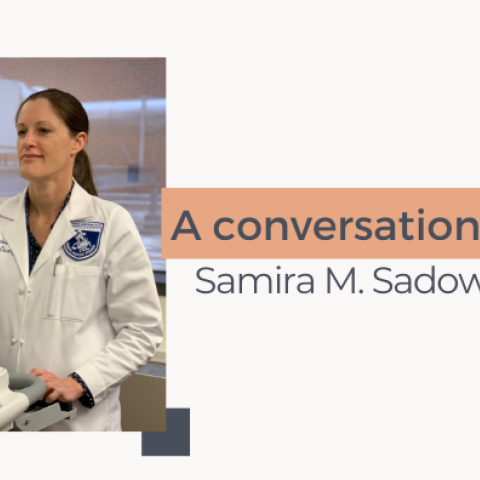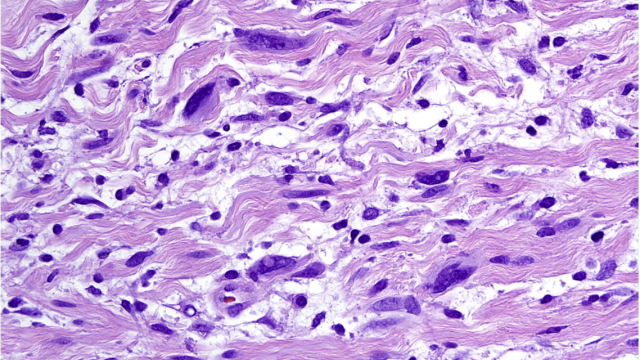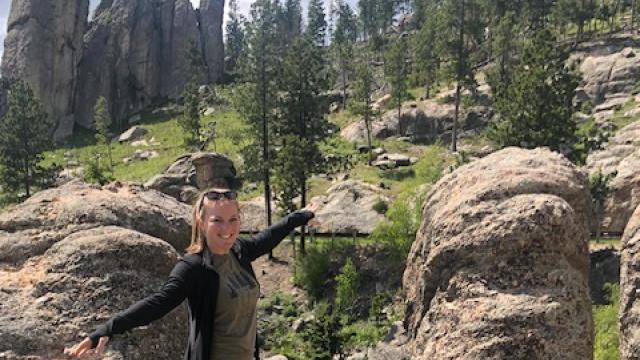
Dr. Sadowski working in the NIH Clinical Center. (This photo was taken prior to the COVID-19 pandemic. Photo credit: Lianne Priede)
Samira M. Sadowski, M.D., is a Physician-Scientist Early Investigator in the Surgical Oncology Program. Along with her role as a surgeon, she studies rare forms of thyroid cancer. Currently, she is looking at neuroendocrine tumors of the pancreas and gastrointestinal tract. Neuroendocrine tumors form from cells that release hormones into the blood in response to a signal from the nervous system. Some examples of neuroendocrine tumors are carcinoid tumors, islet cell tumors and medullary thyroid cancers. In this Q&A, Dr. Sadowski discusses her path to NIH and offers advice for future cancer researchers.
What sparked your interest in cancer research?
I studied transplant medicine in Switzerland for my residency. I was in a pancreatic transplant unit doing clinical work but also research, and that sparked my interest in endocrine research. I was drawn to endocrine cancers, because in addition to being tumors, they can alter hormone secretion. It’s a multisystem and multidisciplinary approach that I enjoy studying.
What are your current research interests?
Neuroendocrine tumors are a diverse and increasingly common set of cancers. My research aims to understand not only how tumors grow and how we can treat them, but really understanding the background of what causes them – the genetics, the drivers – and what causes tumors to be more aggressive or less aggressive.
What questions or challenges are you currently pursuing?
We don’t really have an established model for the type of neuroendocrine tumors I am studying, which affect the pancreas and gastrointestinal tract. Some people have managed to create models, but they have not been very reproducible over time. So, I’m trying to create a model based on cells from patients who I’m taking care of now, growing cell cultures and applying treatments to the cultures to see what results. A big aim of my research is to have a good model that we can study and reuse in the future. Having a reliable and reproducible model is vital for research, particularly in studying the mechanisms and efficacy of drug treatments. We have to prove in vivo (in animal studies) that therapies work before moving them into clinical trials.
I’m also studying the heterogeneity of neuroendocrine tumors, so I’m exploring why cancerous cells are differentially expressed within a tumor or among patients. The aim is to understand why patients have different disease progression and responses to therapy, which may lead to finding new drugs and therapies to target these tumors more accurately.
What brought you to NIH/CCR?
I decided after residency to do a fellowship at NIH/CCR in endocrine surgery. That opportunity allowed me to work side by side with scientists and clinicians, which is a unique feature here. It takes a few years to get data and translate it into clinical use, but you can basically do it all here with collaborators at our core facility. That’s why I came back to this program as a physician-scientist after my fellowship. I’m also driven by patient interactions and being able to answer their questions as a physician-scientist. These interactions are what pushes me to do more research to find answers.
How do you encourage people to participate in clinical trials?
It’s all about communication. It’s our job as doctors to make the information understandable and clear so that potential study participants feel well informed with no surprises. Moreover, potential patients have to feel comfortable asking questions. The more details they can get, the more comfortable they will feel to participate. One thing I’m trying to do is speak at patient group meetings, for example the local Capital Area Carcinoid Neuroendocrine Tumor Survivors group. At these meetings, patients are interested to learn or hear about ongoing clinical trials.
Also, sometimes there are logistical barriers for patients to participate in studies, so NIH often provides financing for certain issues, such as travel expenses, for example. That helps. It’s not always possible, but I think that’s important.
Is there a patient that stood out to you?
It’s a difficult story because I wasn’t able to help a person with a rare form of parathyroid cancer that had already spread, or metastasized. At NIH, we have great imaging techniques that help us find lots of little tumor sites. We’re a last resort for some people whose cancer couldn’t be treated elsewhere. So, we were hopeful that we’d be able to treat this patient, but unfortunately their hormone levels stayed high after we surgically removed the main tumor, which means some tumors may still be present. That was really hard. But we will wait a few months, at which point the remaining tumors may be more detectable, and we will try again with the goal of helping this person.
What advice do you have for future generations of researchers? What about for women pursuing a career in science?
Keep an open mind and ask questions. Even a question that seems to be going to a dead end could suddenly be a very important one. Find your niche, and then go with that. Being a scientist does involve hard work but working with others in a collaborative environment can be a big help. I think that is key.
It is important to understand what support you need to pursue a career in science. For me, it’s support from my family. I am a recent mother, so being supported at work is good, but also having help from family at home makes a big difference.
Also, it’s not absolutely necessary to have female mentors, but having someone you admire in your own field is helpful. There are several women surgeons, such as Martha Zeiger, Director of the Surgical Oncology Program at CCR, and Malin Sund at Umeå University in Sweden, to name only a couple, whom I admire. Knowing their work helped me recognize that different things are possible for female researchers, and it continues to motivate me.


